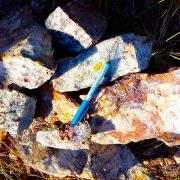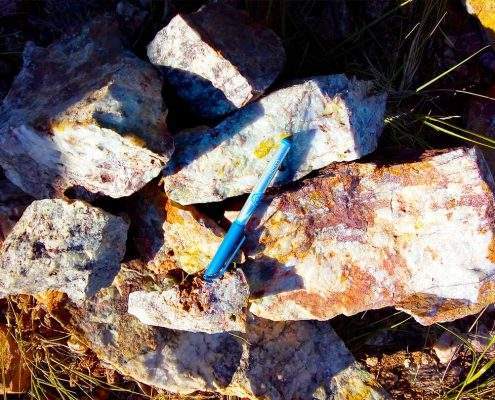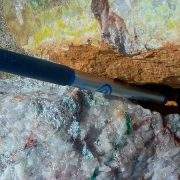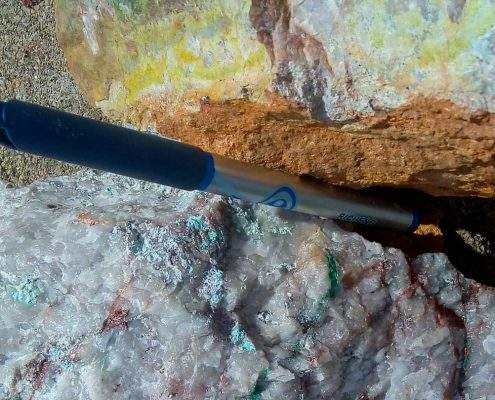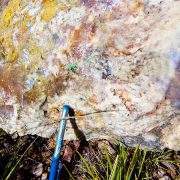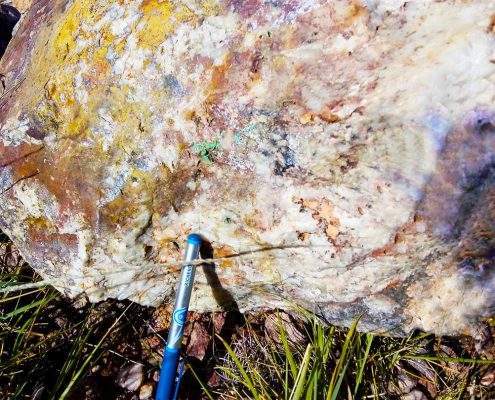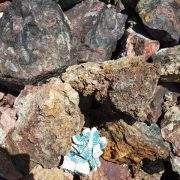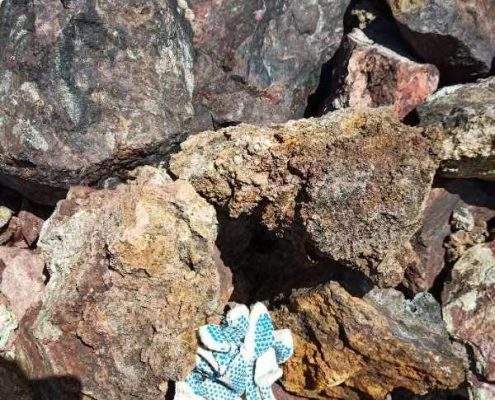Gold Project Assays Results
Ultra Lithium’s Recent Assays Up to 54.77 G/T (1.93 OZ) Gold in Rock Samples
The assay results of rock samples from their newly acquired Gold Mining Licenses in La Rioja Province, Argentine. A total of three grab rock samples were collected from dump material located near the historical mining areas of three mining licenses. These samples were taken for property acquisition due diligence purposes and were tested in two independent laboratories: SGS Laboratories in Burnaby, Canada, and Kunming Metallurgical Research Institute (KMI), China.
Gold Assay Results Range from 7.44 to 54.77 Grams per Ton
The results of samples analyzed at SGS Canada Laboratories indicate gold values in the range of 7.44 gram per ton (g/t) to 54.77 g/t(1.93 oz/t), silver 54 g/t to 125 g/t, copper 0.24 percent (%) to 1.24%, lead 0.09% to 22.90%, zinc 0.02% to 5.01%, iron 2.27% to 28.90%, and vanadium 0.01% to 3.07%. A comparison of assay results for selected elements from both laboratories is provided in Table 1 with location of samples provided in Table 2.
Table 1: Assay Highlights
| Sample ID |
19cal-01 |
19cal-03 |
19esp-05 |
||||
| Element |
Unit |
KMI China | SGS Canada | KMI China | SGS Canada | KMI China |
SGS Canada |
| Gold (Au) |
g/t |
17.34 | 7.44 | 21.09 | 10.98 | 24.54 |
54.77 |
| Silver (Ag) |
g/t |
85.8 | 74.00 | 114.3 | 125.00 | 103.9 |
54.00 |
| Copper (Cu) |
% |
0.80 | 0.24 | 1.00 | 0.95 | 3.00 |
1.24 |
| Lead (Pb) |
% |
4.00 | 9.57 | 9.00 | 22.90 | 0.30 |
0.09 |
| Zinc (Zn) |
% |
0.02 | 0.05 | 3.00 | 5.01 | 0.09 |
0.02 |
| Iron (Fe) |
% |
8.00 | 28.90 | 6.00 | 6.14 | 1.00 |
2.27 |
| Vanadium (V) |
% |
0.20 | 0.21 | 0.06 | 3.07 | 0.04 | 0.01 |
Notes: N.A. – Not analyzed or below detection limits
Table 2: Sample Location
| Sample ID |
AREA / MINING LICENSE |
LOCATION Gauss Kruger Geographic |
|
| 19esp-05 |
ESPIILLO II |
3468569, 6512375 |
31 41 47,6 S 66 21 38,0 W |
| 19cal-01 |
CALLANA VI |
3465818, 6493704 |
31 46 26,5 S 66 21 26,6 W |
| 19cal-03 |
CALLANA V |
3466116, 6494355 |
|
Laboratories Used
Samples were analyzed in two different laboratories using the following packages / techniques.
| Element / Package selected |
SGS CANADA |
KMI CHINA |
| Gold by Fire Assay | Gold by Fire Assay, package GO_FA303 | Gold and Silver by Fire Assay (Code: CF20190131) |
| All other elements | GE_ICP40B | CF20190131-1to6 X-ray fluorescence spectral analysis |
| Over limit packages | GC_AAS42V for silver, GO_ICP90Q for copper, manganese, iron, lead, zinc, GC_ICP93A for vanadium, GE_CSA06V for sulphur |
CAUTIONARY NOTE: Grab surface samples discussed in this news release were taken from historical mine dumps and are not necessarily indicative of mineralization on Ultra Lithium’s properties.
Ultra Lithium Mineralogy Research Study Indicates 79.38% Gold as an Independent Mineral in Rock Samples Assayed
The Company has received the Mineralogy Research Study Report from the Material Composition Department of Kunming Metallurgical Research Institute (KMI) China. The study results show that the average gold content in the samples is 35.916 g/t, with 79.38% gold occurring in the form of an independent mineral, which can be recovered through gravity separation.
Research Highlights:
1) The mineralization is composed of 9 categories of 26 types of minerals, including natural elements, sulfide, oxide, silicate, carbonate, sulfate, phosphate, vanadate and halide, among which oxide accounts for 78.86%, carbonate accounts for 7.64%, silicate accounts for 7.46%, sulfate accounts for 3.48% and other smaller ones.
2) By crushing the mineralized rock to -0.3mm (screening rate > 99%), the cumulative distributions of embedded particles sized above 400 mesh (0.038mm) are:
- Quartz: 99.86%
- Muscovite: 98.86%
- Chrysocolla: 98.86%
- Limonite/hematite: 99.21%
- Malachite: 99.80%
- Atacamite: 99.52%
3) The mineralized rock crushing to 0.3 mm (sieving rate > 99%), dissociation detections of fully dissociated minerals are:
- Quartz: 99.86%
- Muscovite: 51.39%
- Chrysocolla: 39.67%
- Limonite/hematite: 44.11%
- Malachite: 55.85%
- Atacamite: 21.09%
4) Average gold content in samples is 35.916 g/t. Main minerals bearing gold are natural gold, quartz, muscovite, chrysocolla, limonite, hematite, malachite and atacamite. There are two types of gold occurrence: one in an independent form occurring in natural gold accounted for 79.38%, and the other form of mechanical mixing in quartz, muscovite, chrysocolla, limonite, hematite, malachite and atacamite (unable to be identified by optical microscope or scanning electron microscope).
5) Average copper content is 2.45%. Copper mainly occurs in malachite, atacamite and chrysocolla, and a small amount occurs in covellite, calcite and brochanite.
6) Average lead content is 5.87%. Lead mainly occurs in cerusite and sardianite, and a small amount of lead occurs in chervetite.
7) The gold distribution in rock is relatively concentrated, with the distribution of natural gold in the main gold-bearing minerals reaching 79.38%. It is suggested that this part of the gold minerals can be largely recovered through gravity separation.
8) The host rock is mainly composed of massive structures. Some metal minerals, such as limonite and hematite, are sparsely disseminated in the rock, forming a sparse disseminated structure of mineralization. The main structure of metallic minerals is its granular structure, and the main structure of gangue minerals is unequal granular crystallablasstic texture.
9) By microscopic observation, X-ray diffraction analysis, hand panning, electron microprobe analysis and MLA analysis, the results show the natural elements in the rock are as follows: sulfide, oxide, silicate, carbonate, sulfate, phosphate, vanadate and halide in nine categories of 26 kinds of minerals, including oxide (78.86%), carbonate (7.64%), silicate (7.46%), sulfate (3.48%) and other small amounts.
10) Analyses of microprobe and single mineral chemistry confirmed that quartz, muscovite, chrysocolla, limonite, hematite, malachite and cerusite are the main carrier minerals of gold. Mixed rock with -2mm particle size was taken, shrunk and broken to size of -0.3mm, and prepared into MLA resin sample for analysis. The results are as follows:
- Quartz – mainly 6.8 to 300 microns (cumulatively reached 98.06%);
- Muscovite – mainly 3.4 to 212 microns (cumulatively reached 98.86%);
- Chysocolla – mainly 3.4 to 212 microns (cumulatively reached 98.86%);
- Limonite/hematite – mainly 4.8 to 300 micron (cumulatively reached 99.21%);
- Malachite – mainly 6.8 to 150 microns (cumulatively reached 98.00%);
- Atacamite – mainly 4.8 to 106 micron (cumulatively reached 98.17%).
Grab Sample Testing
A total of three grab rock samples were collected from dump material located near the historical mining areas of the newly acquired gold mining licences. These samples were taken for property acquisition due diligence purposes and were tested in two independent laboratories: SGS Laboratories in Burnaby, Canada, and Kunming Metallurgical Research Institute (KMI), China (see Company’s news release dated July 09, 2019). Ultra Lithium also requested KMI was to complete a mineralogy research study.
CAUTIONARY NOTE: The historical information presented above was sourced from the JICA Report entitled, “Informe Sobre Exploracion de Minerales del Area Oeste de la Republica Argentina, Fase II” (March 1994). It is relevant for the further exploration of the project, which the Company intends to undertake in the future. A qualified person has not completed sufficient work to verify the results and the foregoing is presented for informational purposes only and should not be relied upon.


